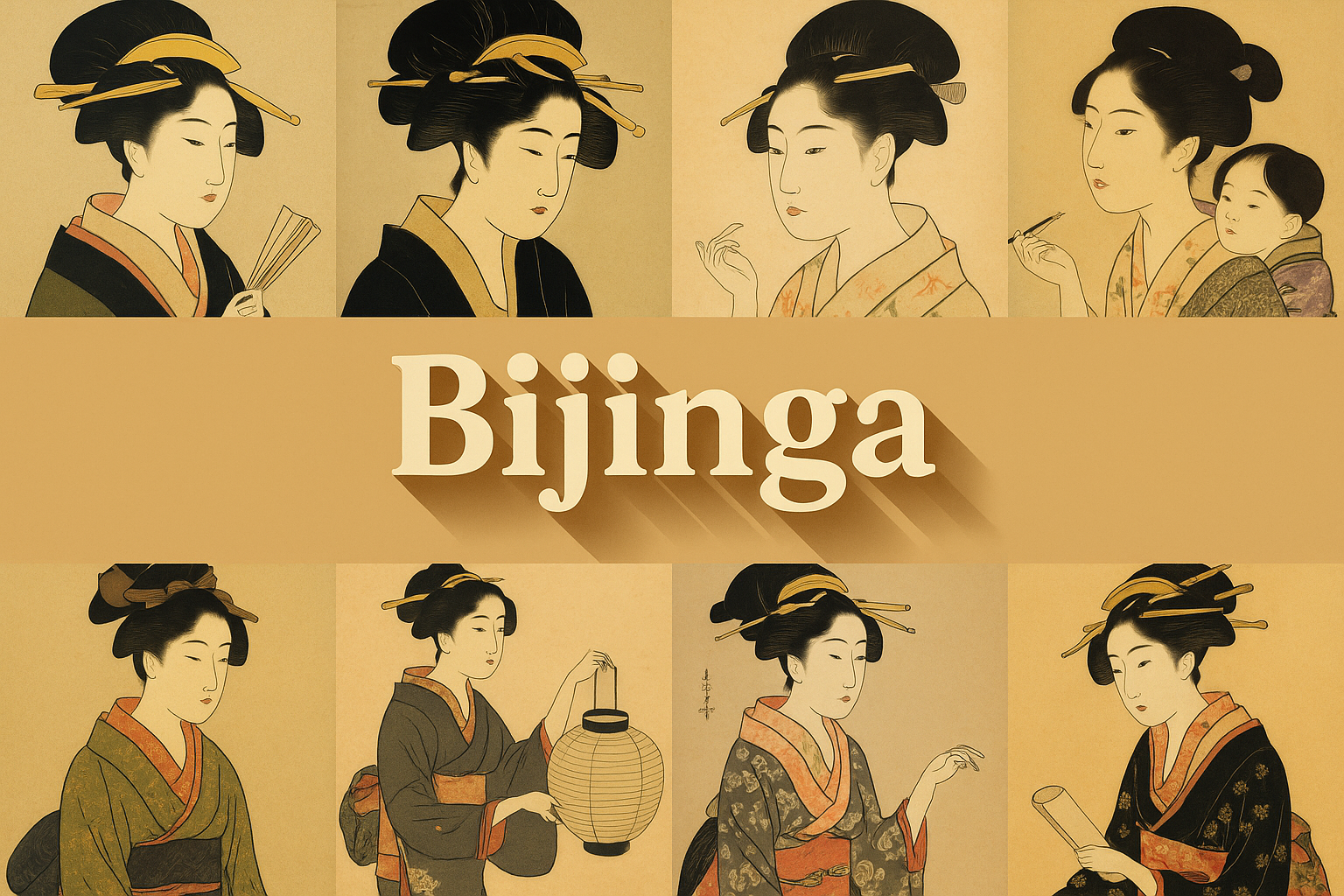
Bijinga
Bijinga is a type of Japanese woodblock print that typically features images of beautiful women. The prints are usually brightly colored and have a very delicate, feminine look.
AOI thinking about Bijinga [+_~]-/
Overview and Quickfacts
Bijinga is a Japanese art style that features beautiful women. The women are often shown in kimonos and with intricate hairstyles. The artwork is highly detailed and often includes elements of nature, such as flowers and birds.
Can understand it also, as:
Bijinga are also known as ukiyo-e, which is a type of Japanese woodblock print.
Categorize it as:
Impressionism, Modernism
.: Dreaming :.
holds a HAIKU for the art style
:. Thought is power .:
Detailed Description
Bijinga is a Japanese painting genre that depicts beautiful women. The word bijinga literally means “beautiful women picture.” The genre is also sometimes called joruri-e, after a type of popular narrative song-drama that often featured beautiful women. Bijinga paintings often depict women in elegant kimono, engaged in traditional activities such as tea ceremony or flower arranging. The women are usually shown in profile, with their faces partially hidden by their obi (sashes). Bijinga first became popular in the Edo period (1603-1868), when the genre was codified by the great ukiyo-e artist Suzuki Harunobu (1724-1770). Harunobu’s delicate and sensual images of women set the standard for the genre, and his work remains highly prized by collectors today. Other notable bijinga artists include Utamaro (1753-1806), who specialized in depictions of beautiful women, and Sharaku (active 1794-1795), who is known for his striking and expressive portraits of kabuki actors and actresses. Bijinga remained popular throughout the Edo period and into the Meiji period (1868-1912). In the 20th century, the genre was taken up by a number of modern artists, including Fujita Tsuguharu (1886-1968), who created a number of striking images of women in Western dress. Today, bijinga continues to be popular with Japanese artists and collectors. The genre is often seen as a celebration of the beauty and grace of Japanese women.
.. beep, beep, beep ..
<START OF TRANSMISSION>
1. Bijinga are Japanese woodblock prints that depict beautiful women. 2. The term bijinga is derived from the Chinese characters for "beautiful" and "woman". 3. Bijinga first became popular in Japan during the Edo period (1603-1868). 4. The ukiyo-e artist Kitagawa Utamaro is considered to be one of the masters of the bijinga genre. 5. Other notable ukiyo-e artists who created bijinga include Utagawa Kunisada, Suzuki Harunobu, and Katsushika Hokusai. 6. Bijinga often depict women engaged in everyday activities such as combing their hair, applying makeup, or reading. 7. The prints often emphasize the beauty of the women's faces and figures. 8. Bijinga were popular among the middle and upper classes in Japan, as they were seen as a status symbol. 9. Many bijinga were intended to be hung in the tokonoma, an alcove in a traditional Japanese home where artworks are displayed. 10. In the 20th century, bijinga fell out of fashion, but there has been a recent resurgence of interest in the genre. 11. Today, bijinga can be found in many art museums and galleries in Japan. 12. The Tokyo Metropolitan Museum of Art has an extensive collection of bijinga, including works by Utamaro, Kunisada, and Hokusai. 13. The Osaka Museum of Fine Arts also has a notable collection of bijinga, with over 1,000 prints on display. 14. The Kyoto National Museum also has a significant collection of bijinga, with over 2,000 prints in its collection. 15. The British Museum in London also has a small but important collection of bijinga, including works by Utamaro, Kunisada, and Hokusai. 16. The Museum of Fine Arts in Boston also has a small collection of bijinga, including works by Utamaro, Kunisada, and Hokusai. 17. The Los Angeles County Museum of Art has a large collection of bijinga, with over 3,000 prints on display. 18. The Freer Gallery of Art in Washington, D.C. also has a small but significant collection of bijinga, including works by Utamaro, Kunisada, and Hokusai. 19. The Art Institute of Chicago also has a small but important collection of bijinga, including works by Utamaro, Kunisada, and Hokusai. 20. The Philadelphia Museum of Art also has a small but important collection of bijinga, including works by Utamaro, Kunisada, and Hokusai.
<EOF>
.. robbel bob
Visual Examples from our image gallery
Coming soon, we are so slow .. might never come
Artists, Paintings, and more
(be aware, can be highly speculative)
Artists (be aware, speculation possible):
X
Artworks (be aware, speculation possible)
X
Epoch
X
AI ART RESSOURCES (AKA, well Tools)
Helping tools -> predefined search links on other pages:











